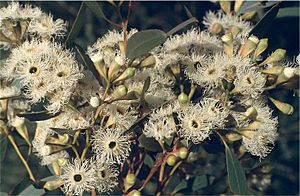Gooseberry mallee facts for kids
Quick facts for kids Gooseberry mallee |
|
|---|---|
 |
|
| Eucalyptus calycogona near Murray Bridge | |
| Scientific classification | |
| Genus: |
Eucalyptus
|
| Species: |
calycogona
|
The Gooseberry Mallee (scientific name: Eucalyptus calycogona) is a special type of eucalyptus tree that grows only in southern Australia. It's known for its smooth bark and unique flower buds and fruits that are shaped like squares! This tree is also called the square fruited mallee because of its cool fruit.
What Does It Look Like?
The Gooseberry Mallee is usually a small tree or a shrub that grows about 5 to 6 meters (16-20 feet) tall. It has a special woody swelling at its base called a lignotuber. This helps the plant regrow after a fire.
Its bark is smooth and can be cream, grey, or even pinkish. Sometimes, the bark near the bottom of the tree can be a bit rough.
When the plant is young, its leaves are dull grey-green and shaped like a spear. They are about 1.8 to 6 centimeters (0.7-2.4 inches) long. As the plant gets older, its leaves become shiny green, narrow, and spear-shaped. These adult leaves are about 5 to 10 centimeters (2-4 inches) long.
The flower buds are super interesting! They grow in groups of seven and are square-shaped. Each bud is about 7 to 13 millimeters (0.3-0.5 inches) long and has four ribs along its sides.
This plant flowers between May and November. Its flowers are usually creamy white, but sometimes they can be pink! After the flowers, the plant grows woody fruits. These fruits are also square-shaped and have four ribs, just like the buds. They are about 5 to 15 millimeters (0.2-0.6 inches) long.
How It Was Named
The Gooseberry Mallee was first officially described in 1852 by a scientist named Nikolai Turczaninow. He gave it the scientific name Eucalyptus calycogona.
There are actually four slightly different types, or subspecies, of the Gooseberry Mallee:
- Eucalyptus calycogona subsp. calycogona: This type has smooth bark all over and smaller buds and fruits. Its flowers can sometimes be dark pink.
- Eucalyptus calycogona subsp. miraculum: This one has a waxy coating on its branches, buds, and fruits.
- Eucalyptus calycogona subsp. spaffordi: This type has wider, thicker leaves and very noticeable ribs on its buds and fruits.
- Eucalyptus calycogona subsp. trachybasis: This subspecies usually has rough bark at the bottom of its main stems and larger buds and fruits.
Where Does It Grow?
The Gooseberry Mallee grows in special areas called mallee woodlands and shrublands. You can find it in Western Australia, South Australia, Victoria, and New South Wales.
The most common type, subspecies calycogona, is found in all these states. It grows in many parts of Western Australia, including the southern and central wheatbelt areas. You can also find it on the Eyre Peninsula in South Australia, in the Big Desert area of Victoria, and near Koraleigh in New South Wales.
Other subspecies grow in more specific places:
- Subspecies trachybasis is found from the eastern side of Spencer Gulf in South Australia, extending into Victoria.
- Subspecies spaffordii only grows in the southern parts of the Eyre Peninsula in South Australia.
- Subspecies miracula is found in an area south of Southern Cross in Western Australia.
This plant often grows alongside other eucalyptus trees like Eucalyptus gracilis, Eucalyptus dumosa, and Eucalyptus oleosa. The smaller plants growing around them include types of Maireana, Sclerolaena, and Chenopodium.
Using the Gooseberry Mallee
People sometimes grow Eucalyptus calycogona in their gardens as an ornamental plant or for shade. It's a great choice for areas near the coast or further inland. This tree is tough and can handle dry weather, lime in the soil, and even some frost. Plus, it's good for the environment because it attracts birds and insects!



